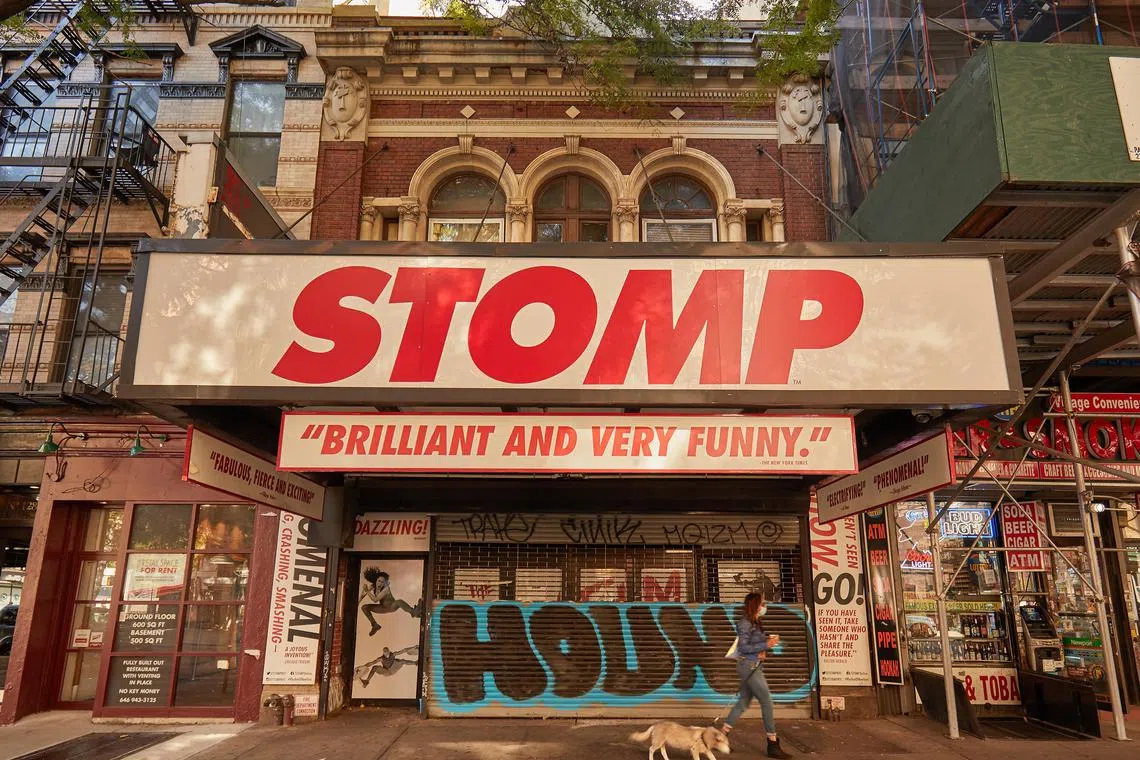Farewell to Stomp, a show at the beating heart of New York
Sign up now: Get ST's newsletters delivered to your inbox

The Orpheum Theatre, which has hosted Stomp for years in New York’s East Village, on Oct 6, 2020.
PHOTO: NYTIMES
Follow topic:
NEW YORK – The stage has no curtain. The set is littered with highway signs and mass transit insignia. And then there are the gigantic oil drums, ominous and puzzling.
It could be a storage facility. Or the site of an industrial warehouse party. But then the sweepers start to trickle in, swooshing across in balletic punk pageantry.
Since its debut in 1994 at Orpheum Theatre in the East Village in Manhattan, Stomp – the wordless percussion spectacle of twirling, tapping, sweeping, banging, clanging and, yes, stomping – has gone from being a scrappy neighbourhood attraction to a mainstay of the culture of New York.
In honour of the show’s 10th anniversary in 2004, a mayoral proclamation declared March 14, 2004, as Stomp Day.
For its 20th birthday in 2014, the Empire State Building shone in red light in its honour. That year, the production was also the centrepiece of the city’s Stomp Out Litter campaign, shot across the five boroughs; and in 2015, the show’s performers participated in a collaboration with another city cultural institution, the Harlem Globetrotters.
The city once even temporarily renamed Second Avenue between Seventh and Eighth Streets “Stomp Avenue”.
In its history, only three occasions have disrupted the continuity of the New York run: the Sept 11 terrorist attacks, a gas explosion on Second Avenue and the coronavirus pandemic.
Even as commercial stores booted out local businesses, rents shot up and students and artists moved farther downtown, the show hung on in an ever-shifting neighbourhood.
But after 29 years, the production will close for good on Sunday because of declining ticket sales.
“Say it ain’t so,” said music producer Lou George, who is widely known as Bowlegged Lou.
A Stomp super fan, he said he had seen the show 225 times and planned to see it once more before the cast takes its final bows.
“I’m having withdrawals,” he said. “Stomp was such a fixture in New York.”
Part drum line, part step team, part ensemble of city buskers, Stomp is a show in which timing is everything.
The cast of eight perform with repurposed household objects and urban detritus, creating rhythm out of rubbish cans, suitcases, radiator hoses and precision choreography, all while threading in humour through one-upping showdowns and zany mishaps.
Anything can become music: fingernails scratching against match boxes; basketballs passed back and forth with a thud.
Stomp has had unusually global reach. It has been spoofed on animated sitcom The Simpsons, included as an answer on game show Jeopardy! and performed in 45 countries – including at the Acropolis in Greece and the 2012 London Olympics closing ceremony.
Still, it remained a symbol of the cultural landscape of New York. But it was not born there.
It was conceived by two Britons – creators and directors Luke Cresswell and Steve McNicholas, who met as street performers in Brighton, England, in the early 1980s.
Together, they formed musical groups that mixed percussion, vocals and comedy, and after experimenting with one-off performances using only brooms and rubbish bins, they premiered Stomp at the Edinburgh Fringe Festival in 1991.
“We concentrated on the rhythmic elements,” said McNicholas, “but I think we remained aware of the inherent absurdity of the concept of using everyday objects as instruments, so the humour was there from the start.”
When the show arrived in New York in the early 1990s, the East Village was home to performance art company Blue Man Group, punk club CBGB and the indie-rock club Brownies.

Actors perform in Stomp at the Orpheum Theatre in New York on Dec 27.
PHOTO: NYTIMES
Cresswell and McNicholas found the punk downtown, far from the bright lights of Broadway, a perfect fit for their deadpan show.
“It’s not glamour, it’s not cute sets,” said Cresswell. “It’s a small, funky little theatre with people doing it really close to you. You feel and smell the sweat.”
Cresswell and McNicholas were not sure if the show would make it through its original four-month run, yet it has outlasted much of the neighbourhood’s arts ecosystem from those early days.
Brownies went dark in 2002, CBGB in 2006, and the Blue Man Group was acquired by Cirque du Soleil in 2017.
And one by one, many of the Stomp cast and creators’ go-to East Village locales shut their doors: the adjacent luncheonette Stage Restaurant, the corner bar and bistro Virage, and Gem Spa, the nearly 100-year-old bodega across the street, which closed in 2020.
Still, Stomp endured for nearly three decades, rivalling The Phantom Of The Opera, which is set to close in 2023 after 35 years onstage. Throughout Stomp’s touring and Orpheum Theatre productions, Cresswell and McNicholas retained artistic control and directorship.
Stomp publicist Jackie Green said flagging international tourism after pandemic lockdowns was a factor in deciding to close, but she declined to share financial figures. The North American and European touring shows will continue to run.
McNicholas said that he felt for the New York performers, who in the past year were performing for “tiny” houses, though neither the energy onstage nor the enthusiasm in the audience had let up, he said.
“I’m a little bit sad because I feel like we were part of the East Village,” said McNicholas. “We were part of the landscape of the Village, and it’s a shame to say goodbye to that.”
Alan Asuncion, a member of the final New York Stomp cast who has performed at the Orpheum since 2007, said: “Playing on objects to create music has been around forever. But the creators brilliantly put it into a piece of theatre that has become a household name. And that legacy will live on.” NYTIMES

